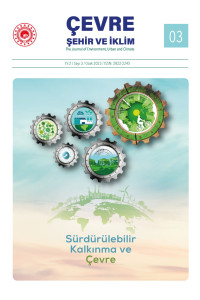Öz
Küresel üretim ve tüketimin giderek artan olumsuz etkisi nedeniyle, ürün yaşam döngüsü boyunca kullanılan kaynak hacmini azaltılması büyük önem taşıyan bir konu haline gelmiştir. Tüketicileri kullandıkları ürünlerin tüm yaşam döngüleri boyunca doğal çevre üzerindeki etkisi konusunda bilgilendiren ve aynı zamanda üreticilere ürünlerinin avantajları hakkında tüketicileri bilgilendirme fırsatı da verebilecek bir sistem geliştirmek zorunluluğu ortaya çıkmıştır. Türkiye'de Çevre Etiketi Sistemi, 66/2010/EC sayılı AB Eko-etiket Yönetmeliği ile uyumlu olarak 2018 yılında yürürlüğe giren Çevre Etiketi Yönetmeliği ile Türkiye Çevre Etiketi Sistemi kurulmuştur. Türkiye Çevre Etiket Sistemi, tüm faaliyetlerin ISO 14024 standartlarına uygun olarak yürütüldüğü bir Tip 1 Eko-etiket sürecidir. Çevre ve Şehircilik ve İklim Değişikliği Bakanlığı, Çevre Etiket Sistemi'nin sahibi ve uygulayıcı kuruluşudur. Bu kapsamda, Bakanlık tarafından bugüne kadar turistik konaklama hizmetleri, temizlik kağıdı, tekstil, seramik kaplama, elde yıkama bulaşık deterjanı, kişisel bakım ve kozmetik, cam, çamaşır deterjanı ve bulaşık makinesi deterjanı ürün gruplarında Çevre Etiketi kriterleri yayımlanmış, yedi ürün grubuna çevre etiketi verilmiştir. Bakanlık, 2023 yılı sonuna kadar toplam 12 ürün grubunda olacak şekilde mobilya, doğal taş, hijyenik ürünler ve sert yüzey temizleyiciler ürün grupları için çevre etiketi kriterleri geliştirilmesini hedeflemektedir. Bu makalede, eko-etiket sistemleri hakkında genel bir bilgi verilmekte, ardından Türkiye Çevre Etiket Sistemi tanıtılmaktadır.
Anahtar Kelimeler
Sürdürülebilir Üretim ve Tüketim Döngüsel Ekonomi Yeşil Mutabakat Eko-Etiket Türkiye Çevre Etiket Sistemi
Kaynakça
- Aydın, G. Ş. (2019). “Eko Etiketleme ve Türkiye Çevre Etiketi”, Harran Üniversitesi Mühendislik Dergisi, 4(1); 40-47.
- Eylem B.(2020). Çevre Etiketi: Sürdürülebilir Çevre Hedefleri İçin bir Araç mı Çevre Duyarlılığının Piyasalaştırılması mı? Ekonomi ve Yönetim Bilimlerinde Güncel Akademik Araştırmalar, Editör: Mustafa Hatipler, Akademisyen Kitabevi A.Ş.
- BlueAngel (1978). Blue Angel – Good for me. Good for the environment. https:// www.blauer-engel.de/en/blue-angel/our-label-environment BlueAngel (2020).
- Technical Documents. https://www.blauer-engel.de/en/certification/technicaldocuments.
- BlueAngel (2022). Development and testing of criteria. https://www.blauer-engel.de/en/blue-angel/our-label-environment/developed-scientific-basis.
- Castro, C. G., Trevisan, A. H. Pigosso D. A. and Mascarenhas J. (2022). “The rebound effect of circular economy: Definitions, mechanisms and a research agenda”.
- Journal of Cleaner Production: 131136.
- Ecolabel (1992). Council Regulation (EEC) No 880/92 of 23 March 1992 on a Community eco-label award scheme. https://eur-lex.europa.eu/legal-content/EN/ TXT/?uri=CELEX%3A31992R0880.
- EPA (2022). “Introduction to Ecolabels and Standards for Greener Products”. https://www.epa.gov/greenerproducts/introduction-ecolabels-and-standardsgreener- products.
- EU (2003). “Communication from the Commission to the Council and the European Parliament, Integrated Product Policy”. http://eur-lex.europa.eu/LexUriServ/LexUriServ.do?uri=COM:2003:0302:FIN:en:PDF.
- EU (2008). “Communication from the Commission to the European Parliament, the Council, the European Economic and Social Committee and the Committee of the Regions on the Sustainable Consumption and Production and Sustainable Industrial Policy Action Plan”.COM(2008) 397 final Brussels, 16.7.2008
- EU (2020). “About the EU Ecolabel”. https://environment.ec.europa.eu/topics/ circular-economy/eu-ecolabel-home/about-eu-ecolabel_en.
- EU (2022). “European Union Ecolabel facts and figures”. https://environment.ec.europa.eu/topics/circular-economy/eu-ecolabel-home/business/ecolabel-factsand-figures_en.
- Europe (2022). “The EU Ecolabel as a driver to circular economy”. https://www.sustaineurope.com/the-eu-ecolabel-as-a-driver-to-circular-economy.html.Iraldo, F., Griesshammer, R. and Kahlenborn W. (2020). “The future of ecolabels”.25(5): 833-839.
- ISO (1999). ISO 14021 (1999) “Environmental labeling declarations - Selfdeclared environmental claims (Type II Labels)”, International Organization for Standardization.
- ISO (1999). ISO 14024 (1999) Labeling and Environmental Declarations - Type 1 Environmental Labeling, International Organization for Standardization.
- ISO (2000). ISO 14020:2000, Environmental labels and declarations — General principles
- ISO (2000). ISO 14025 (2000) Environmental Labels and Declarations, Type III Environmental Declarations, International Organization for Standardization, International Organization for Standardization.
- Marrucci, L., Daddi T.and Iraldo F. (2019), "The integration of circular economy with sustainable consumption and production tools: Systematic review and future research agenda". Journal of Cleaner Production, 240: 118268.
- Meis-Harris, J., Klemm, C., Kaufman, S., Curtis, J., Borg K. and Bragge, P. (2021). What is the role of eco-labels for a circular economy? A rapid review of the literature. Journal of Cleaner Production, 306: 127134.
- NordicSwan (1989). The official ecolabel of the Nordic countries. https://www.nordic-ecolabel.org/nordic-swan-ecolabel/.
- Pezikoğlu, F. (2016). "Yeşil Ekonomi Göstergeleri ve Yeşil Etiketler". XII. Ulusal Tarım Ekonomisi Kongresi. 25-27 Mayıs 2016. Atatürk Bahçe Kültürleri Merkez Araştırma Enstitüsü, (1389-1398), Yalova.
- Prieto-Sandoval, V., Mejía-Villa, A., Ormazabal, M. and Jaca, C. (2020). "Challenges for ecolabeling growth: lessons from the EU Ecolabel in Spain". The International Journal of Life Cycle Assessment, 25(5): 856-867.
- Tseng, M.L., Chiu, A. S. F., Liu, G. and Jantaralolica, T. (2020). "Circular economy enables sustainable consumption and production in multi-level supply chain system". Resources, Conservation and Recycling, 154: 104601.
- Wojnarowska, M., Sołtysik, M., and Prusak, A. (2021). "Impact of eco-labelling on the implementation of sustainable production and consumption". Environmental Impact Assessment Review, 86, 106505.
Ayrıntılar
| Birincil Dil | Türkçe |
|---|---|
| Konular | Çevre ve Kültür |
| Bölüm | Araştırma Makaleleri |
| Yazarlar | |
| Yayımlanma Tarihi | 31 Ocak 2023 |
| Yayımlandığı Sayı | Yıl 2023 Sayı: 3 |


